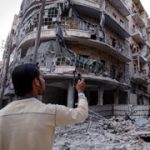This blog post is part of PHR’s Tech & Human Rights Blog Series. The series is meant to highlight the intersection between technology and human rights, and examine the increasing role that technology can play in advancing human rights around the world.
One of the questions I am asked most often about my work on the Syria mapping project at Physicians for Human Rights (PHR) is how we are able to conduct our research and documentation without being on the ground in country. How can we get detailed and unbiased information and corroborate 242 attacks on medical facilities and 615 deaths of medical personnel from afar?
The short answer is technology. The Syrian civil war has been the most widely followed conflict on social media. There is no shortage of activists, citizen journalists, and armed groups using Twitter, Facebook, and YouTube to capture events and spread information – or misinformation in some cases. Often, written posts are short and do not offer details – reporting only that a hospital has been “targeted” – but eyewitness photos and videos can fill in gaps by providing an “on-the-ground” view that would otherwise be impossible to get.
Photos and videos allow us to view the signage on the targeted facility, the medical equipment on the premises (or lack thereof), and the type and extent of material damage. These visual data are key to our documentation, allowing us to identify the facility and its location, confirm whether it was functioning at the time of attack, assess whether the damage matches the weapons reportedly used, corroborate the extent of damage and destruction, establish an accurate timeline for the attack, and – at times – even identify the perpetrator.
However, the power of social media can only be harnessed when Syrian documenters have access to electricity to charge their phones and to the internet to post photos and videos. In the midst of a relentless conflict, power lines are destroyed unintentionally by fighting or intentionally by armed groups; snow storms cut off fragile electricity; and oil prices increase, making fuel for generators prohibitively expensive. Thus, the flow of reliable information stops. Activists may be able to tweet an update or two, but 140 characters does not leave room for the detailed information PHR requires to corroborate attacks on hospitals and deaths of medical personnel.
In January and February of 2015, we saw a notable decline in the number of available images and videos documenting attacks on medical facilities. In January, we did not link to any videos, and February 2015 was the only month in which we had neither photos nor videos. Except for these two months, PHR has, on average, linked to more than four videos and four photos each month on our interactive map for the last year.
There are a number of possible explanations for the decrease in photos and videos; there could have been decreased access to electricity due to winter snow storms, the fighting could have been so intense that there wasn’t time to document, or Syrians may have collectively felt that their documentation wasn’t making enough of a difference to continue risking their lives for it. The observed decrease beginning in 2015 could also just have been a coincidence, rather than an ongoing trend. But whatever the reason, the lack of visual documentation over those two months made corroborating attacks on medical facilities tremendously more difficult.
Fortunately, there are enough Syrians dedicated to documenting human rights violations that we are often able to get information that we need, even if it comes in the form of written reports rather than photos and videos. But this may change in the future. With the conflict into its fifth year and access to technology becoming even more limited, Syrians may grow weary in continuing their online documentation. After all, the world’s response to the countless documented violations has been lackluster, at best.
Technology is only as useful as the information it spreads. If the quality and amount of information coming out of Syria decreases significantly, we will need to think more creatively about how we can continue documenting and bringing ongoing violations to light.

